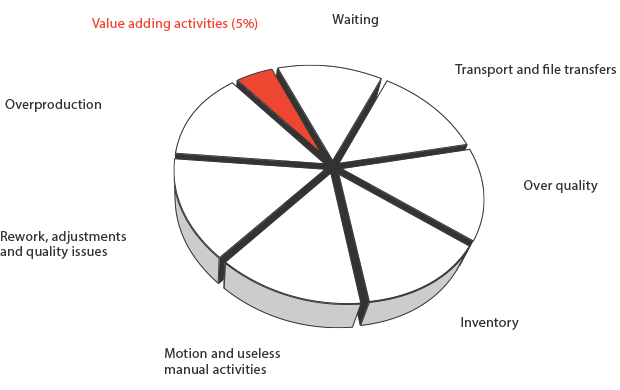What is waste ? an activity the customer is not willing to pay.
The 7 basic “wastes” of the industrial environment are well known and identifiable. But can the same categories be used for waste in services or administrative activities?
The 7 basic “wastes”

1 – Overproduction
Overproduction consists in producing in larger quantities than required by customers ‘demand, and not just what is needed: any redundant work or performed too far upstream of the customer’s needs, such as copies of reports sent automatically, multiple forms for the same information, double data entry, etc..
2 – Waiting
Waiting for information, decisions, validation, without considering waiting at the end of a meeting, waiting before printing…
Poor time management can let us process what is urgent before what is important, generating waiting for a file to be processed, and lead time increase. A sub-form of this are interruptions, or interferences: a colleague visit or immediate request, frequent emails consultation, responding to unexpected and sudden events, or simply being disturbed by a noise that cannot be ignored. Moreover, everyone knows that interruptions create a lot of time waste for the time to get focus again on the task you were doing can be long.
3 – Transportation and file transfer
Everything that requires unnecessary people movement or product transportation between two process steps and that does not add value. Processing or transferring a file sequentially, via e-mail, from one department to another is one of the most important time wastes in administrative activities.
4 – Overquality
All activities which consist in serving the customer (internal – external) above his expectations. They do not give value to the product or service and require employees ‘time. They often result from a poorly defined standard, overzealousness, or misidentified client expectation.
Examples: Sending to the client extra technical documents to complete a transaction if they are not requested, check a calculation already made by another service, redo a request from a supplier, etc.
5 – Inventory
Inventory of products, material and consumables (toners, pencils, etc.) which exceed actual demand/requirement.
6 – Unnecessary motion
All the unnecessary gestures and movements that employees make during their daily activities: opening several software screens to complete a transaction, looking for misplaced files, etc. Searching for information, whether it’s a physical file or a misclassified file on one’s computer, is a major waste.
7 – Rework and defects
Everything which is not Right First Time: errors and corrections lead to rework, generate incorrect invoices, badly filled forms … Rework goes against the principle of “doing well first time”, and it is a major cause of Failure Demand in every department.
It can be caused by the process, by poor information on customers’ needs, lack of standards or procedures, or a lack of coordination between services. It results in the need to get additional resources to avoid disrupting the normal course of business.
Organizational requirements or internal instructions can often also reduce the efficiency of administrative services: providing information for calculations or statistics, reports to write, or meetings to attend that do not help to serve clients.
As you can see, all the wastes usually presented in the industrial environment can be applied in one way or another to office and service processes. However, it should not be limited to these. Real opportunities may also exist elsewhere than in this first level of waste, for example in the way processes are structured today.
The management role is to give to his team a new vision of efficiency and of what is expected by the customer, to be able to identify process wastes and inefficiencies, and to reduce them by effective teamwork .

